Japan
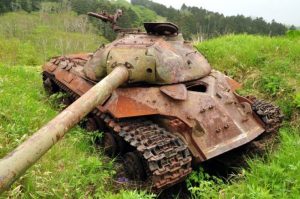 War machines…the weapons of war…everything from tanks to airplanes to ships. A war cannot be fought without the equipment that transports, shoots, bombs, floats, and flies over the war. What happens to the shattered remains of the equipment that didn’t make it back to base? Obviously, if a ship is hit, it ends up at the bottom of the ocean, as does a submarine, but what of the planes, tanks, jeeps, and even the bases that have been bombed out, shot up, or otherwise rendered useless? The world is littered with the wreckage of the many wars that have taken place over the years of human existence, because humans have a propensity for fighting. We don’t like when things don’t go our way, and if we don’t understand that we can’t always have it our way, we tend to go to war.
War machines…the weapons of war…everything from tanks to airplanes to ships. A war cannot be fought without the equipment that transports, shoots, bombs, floats, and flies over the war. What happens to the shattered remains of the equipment that didn’t make it back to base? Obviously, if a ship is hit, it ends up at the bottom of the ocean, as does a submarine, but what of the planes, tanks, jeeps, and even the bases that have been bombed out, shot up, or otherwise rendered useless? The world is littered with the wreckage of the many wars that have taken place over the years of human existence, because humans have a propensity for fighting. We don’t like when things don’t go our way, and if we don’t understand that we can’t always have it our way, we tend to go to war.
On an island in the North Pacific, lies a remote island called Shikotan, at the southern end of the Kuril archipelago. The island seems like a simple place, green and lush in the summertime, but the island hides a secret. It has one particularly astonishing characteristic. The island is dotted with the decaying hulks of Russian 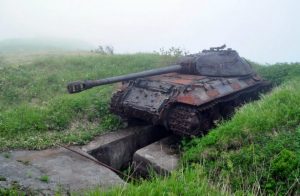 military tanks from the 1950s. And these rusting relics hint at the troubled past…and present of Shikotan. Shikotan is a part of an ongoing battle for ownership between Russia and Japan.
military tanks from the 1950s. And these rusting relics hint at the troubled past…and present of Shikotan. Shikotan is a part of an ongoing battle for ownership between Russia and Japan.
Shikotan is part of the Kuril archipelago, a chain of islands stretching from the southeastern tip of Russia to the north of the Japanese island of Hokkaido. The Pacific lies on one side of the Kuril Islands, with the Sea of Okhotsk found on the other. Its location makes it an important island to both countries, hence the battle. After World War II, the San Francisco Peace Treaty, which was signed between the Allies and Japan in 1951, stated that Japan must give up “all right, title and claim to the Kuril Islands.” Unfortunately, it didn’t specifically recognize the Soviet Union’s sovereignty over them. That allowed the dispute that has ensued. Japan claims that at least some of the disputed islands are not a part of the Kuril Islands, and thus are not covered by the treaty. Russia maintains that the Soviet Union’s sovereignty over the islands was recognized in post-war agreements.
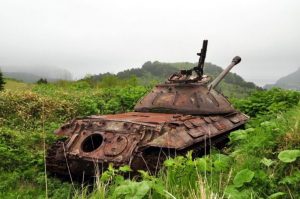
Since that time, Japan and the Soviet Union had been fighting over the island. They finally ended their formal state of war with the Soviet–Japanese Joint Declaration of 1956, but did not resolve the territorial dispute. During talks leading to the joint declaration, the Soviet Union offered Japan the two smaller islands of Shikotan and the Habomai Islands in exchange for Japan renouncing all claims to the two bigger islands of Iturup and Kunashir, but Japan refused the offer after pressure from the US. Japan did not really intend to give up the island, and no one really knows how strong their army there was, but what is left on the island are the remnants of that army…a few masterpieces of Soviet engineering, IS-2 and IS-3 tanks.
 When Audrianna “Anna” Masterson was born, her mom, Dustie Masterson, knew that the baby girl completed their family. Now, 12 years later, her mom says that Anna’s very presence makes her smile. Anna loves cheesy jokes as much as her mom, so they laugh and joke off of each other a lot. Still, those 12 years weren’t all carefree and easy…just mostly. Once, when Anna was just three years old, she gave her parents quite a scare. They were freaking out because she had buried herself in a pile of clothes and fallen asleep. Anna slept so soundly, that she did not hear her family yelling and screaming her name. Still, if that is the worst thing Anna ever does, I’d say she’s a keeper. Her parents, Rob and Dustie are finding it really hard to believe Anna is
When Audrianna “Anna” Masterson was born, her mom, Dustie Masterson, knew that the baby girl completed their family. Now, 12 years later, her mom says that Anna’s very presence makes her smile. Anna loves cheesy jokes as much as her mom, so they laugh and joke off of each other a lot. Still, those 12 years weren’t all carefree and easy…just mostly. Once, when Anna was just three years old, she gave her parents quite a scare. They were freaking out because she had buried herself in a pile of clothes and fallen asleep. Anna slept so soundly, that she did not hear her family yelling and screaming her name. Still, if that is the worst thing Anna ever does, I’d say she’s a keeper. Her parents, Rob and Dustie are finding it really hard to believe Anna is  turning 12 this year.
turning 12 this year.
Anna is very into Anime…which is hand-drawn and computer animation game out of Japan. I’m told that her sister, Raelynn can be held responsible for this. Apparently, she doesn’t love board games…or so she says, but when the family sits down to play, she has a blast. The same applies to bowling. The latest thing these days is Comic-Con, and Casper is holding their very first Comic-Con. Raelynn and Anna are going this weekend. Anna graduated from elementary school this year and her graduation gift was a ticket to go to Comic-Con with her best friend Julie. She was also invited to go with a close friend of the family and his daughter who is a  good friend of Anna’s too.
good friend of Anna’s too.
Anna loves to read, and can often be found reading on her phone. I can relate to that. There is a whole world of stories and information out there. All we have to do is pick up a book, or even our phone. Anna is a very soft hearted girl, and she depends on her siblings, with whom she is very close, whenever she is upset…which isn’t really very often, but she counts on them when she is. She looks to both of them and will call them on the phone, if they are not home. While she depends on her siblings, Anna really enjoys having her own room for the first time ever. As she grows up, she is finding out that having your own space is really cool too. Today is Anna’s 12th birthday. Happy birthday Anna!! Have a great day!! We love you!!
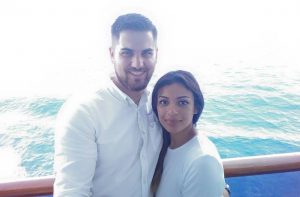 My niece, Gaby Beach spent much of her post high school years in the Navy. She worked very hard to get there, and continues to be an exercise enthusiast, and an inspiration to many people who would love to have such determination to stick to a program. She needed to get in shape to get into the Navy, and she wasn’t going to let anything stand in her way, especially something like a lack of determination. Now, she works out just about every day, because she doesn’t ever want to go back to a time when she was not physically fit.
My niece, Gaby Beach spent much of her post high school years in the Navy. She worked very hard to get there, and continues to be an exercise enthusiast, and an inspiration to many people who would love to have such determination to stick to a program. She needed to get in shape to get into the Navy, and she wasn’t going to let anything stand in her way, especially something like a lack of determination. Now, she works out just about every day, because she doesn’t ever want to go back to a time when she was not physically fit.
While in the Navy, Gaby had the opportunity to be involved in a program that brought dogs into hospitals for the purpose of healing through comfort. Gaby loved that program, and since my mother-in-law was in a nursing home the last 5 years of her life, I can attest to the value of these dogs. So many of the residents loved the dogs that belonged to employees of the facility, and who wandered around the facility, “making their rounds” as it were. They were almost like little canine doctors. The experience was precious. The work Gaby did there was a benefit to many people.
Gaby has been a student for much of her life too, because she wants to prepare for her chosen career in nursing. Beginning January 20th, she will begin the journey through nursing school, and we are all very excited 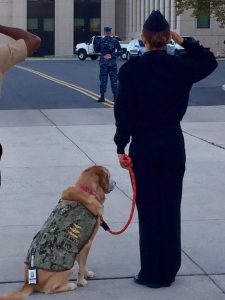 for her. During her time in the Navy, Gaby worked as a corpsman, so nursing is right up her alley. She was stationed in Japan, when she met my nephew, Allen Beach, and they have been married for four years now.
for her. During her time in the Navy, Gaby worked as a corpsman, so nursing is right up her alley. She was stationed in Japan, when she met my nephew, Allen Beach, and they have been married for four years now.
While Allen was going to school, Gaby worked, and then once Allen was hired by Wyoming Medical Center, it was Gaby’s turn. They moved to Casper, and she began the pre-requisites for the nursing program. Once those were done, she applied and was accepted into the program, and now she is waiting excitedly for the semester to begin. Gaby knows a lot about the nursing field, having come from a corpsman background, so there should be no surprises for her in the program. It is an exciting journey, and I am excited for her. Nursing school is a lot of hard work, but I know that she will do just fine, and very soon, she will be Nurse Gaby. Today is Gaby’s birthday. Happy birthday Gaby!! Have a great day!! We love you!!
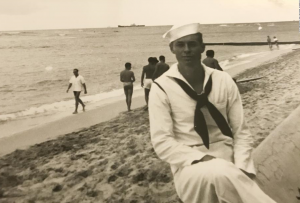 When someone is killed in a war, we are always in the hope that they will be found quickly, and identified by their friends, so that their remains can be returned to their family for a proper burial. Unfortunately, that is not always the case. Nevertheless, we hope that the time passing between death and identification is a very short amount. Unfortunately that was not the case with Carl David Dorr, who was one of the 429 sailors and Marines killed on board the USS Oklahoma when it was sunk in the Japanese attack on Pearl Harbor. Only 35 people on the ship were positively identified and buried in the years immediately following the December 7, 1941, military strike, according to the Defense Department. The unidentified remains were buried as unknowns at the National Memorial Cemetery of the Pacific, which fills the Punchbowl crater in Honolulu. For 77 years, Dorr’s family has been waiting and wondering what became of him. They knew he was at Pearl Harbor, and that he
When someone is killed in a war, we are always in the hope that they will be found quickly, and identified by their friends, so that their remains can be returned to their family for a proper burial. Unfortunately, that is not always the case. Nevertheless, we hope that the time passing between death and identification is a very short amount. Unfortunately that was not the case with Carl David Dorr, who was one of the 429 sailors and Marines killed on board the USS Oklahoma when it was sunk in the Japanese attack on Pearl Harbor. Only 35 people on the ship were positively identified and buried in the years immediately following the December 7, 1941, military strike, according to the Defense Department. The unidentified remains were buried as unknowns at the National Memorial Cemetery of the Pacific, which fills the Punchbowl crater in Honolulu. For 77 years, Dorr’s family has been waiting and wondering what became of him. They knew he was at Pearl Harbor, and that he  was on the USS Oklahoma. The bodies were there, but they could not be identified. I can’t think of anything that would be more frustrating than that. Sadly, the wait was beyond long…it was 77 years. When I think about his family, first losing their 27 year old son, and then not being able to bury their son. They died without that closure.
was on the USS Oklahoma. The bodies were there, but they could not be identified. I can’t think of anything that would be more frustrating than that. Sadly, the wait was beyond long…it was 77 years. When I think about his family, first losing their 27 year old son, and then not being able to bury their son. They died without that closure.
Carl’s family, like most American families, gathered around the radio on December 7, 1941. The news was grim. They didn’t know much yet, but they knew Carl’s ship had been attacked. With sinking hearts, they tied to hold out hope that by some miracle, he had survived. Then, they received the crushing news that he was missing in action…then, presumed dead. After the Defense Department began DNA collection in 2009, his family provided samples in hopes that one day it would help identify Carl’s body, his nephew said. His mother kept an heirloom photograph in her living room “so she could keep an eye on him,” Thomas Dorr said. She was  able to see her son every day, even if he never made it home at all. And, of course, he never did, at least during their lifetime.
able to see her son every day, even if he never made it home at all. And, of course, he never did, at least during their lifetime.
Recently, the DNA provided for identification purposed, finally paid off. Dorr’s body was finally identified, and he was going home at last. About 15 of Dorr’s relatives walked onto the tarmac of South Carolina’s Greenville-Spartanburg International Airport. As they watched, a flag-draped coffin was lowered from the plane into a hearse. “There was nothing but dead silence,” Carl’s 70-year-old nephew, Thomas Dorr, who lives in St. Johns, Florida, told CNN. “I knew that what I was experiencing was history.” Carl David Dorr was finally going to be laid to rest, and how fitting that his funeral would be held on the same day that he died, December 7, but 77 years after the day he died…Pearl Harbor Day.
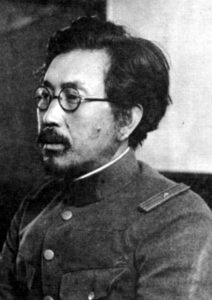 When we think of wartime atrocities, most of us think of the Holocaust, and that was indeed a horrible atrocity. Nevertheless, there have been a number of horrible dictators in history, and most of them committed some kind of atrocity. One of the worst atrocities in history, is one that very few people even know about. Most people have heard about the horrible experiments the Nazis performed on humans. The Nazi doctor, Joseph Mengele headed up that torture practice. But the Nazis weren’t alone in conducting cruel experiments on humans. The Imperial Japanese Army’s Unit 731. Some of the details of this unit’s activities are still uncovered. I don’t understand how anyone could have such little regard for human life, as to conduct some of the horrible experiments n them that some of these dictators and their cohorts did.
When we think of wartime atrocities, most of us think of the Holocaust, and that was indeed a horrible atrocity. Nevertheless, there have been a number of horrible dictators in history, and most of them committed some kind of atrocity. One of the worst atrocities in history, is one that very few people even know about. Most people have heard about the horrible experiments the Nazis performed on humans. The Nazi doctor, Joseph Mengele headed up that torture practice. But the Nazis weren’t alone in conducting cruel experiments on humans. The Imperial Japanese Army’s Unit 731. Some of the details of this unit’s activities are still uncovered. I don’t understand how anyone could have such little regard for human life, as to conduct some of the horrible experiments n them that some of these dictators and their cohorts did.
For 40 years, the horrific activities of “Unit 731” remained one the most closely guarded secrets of World War II. It was not until 1984 that Japan acknowledged what it had done and long denied. The vile experiments on humans conducted by the unit in preparation for germ warfare were atrocious. The Japanese doctors deliberately infected people with plague, anthrax, cholera and other pathogens. It is estimated that as many as 3,000 enemy soldiers and civilians were used as guinea pigs. Some of the more horrific experiments included surgery without anesthesia to see how the human body handled pain, and pressure chambers to see how much pressure a human could take before his eyes popped out.
The compound for Unit 731 was set up in 1938 in Japanese-occupied China with the aim of developing biological weapons. It also operated a secret research and experimental school in Shinjuku, central Tokyo. Its 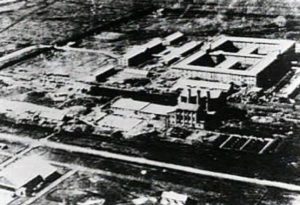 head was Lieutenant Shiro Ishii. Japanese universities and medical schools also supported the unit, by supplying doctors and research staff. I can’t imagine being assigned to such a facility. The picture now emerging about Unit 731’s activities is horrifying. According to reports, which were never officially admitted by the Japanese authorities, the unit used thousands of Chinese and other Asian civilians and wartime prisoners as human guinea pigs to breed and develop killer diseases. Many of the prisoners, who were murdered in the name of research, were used in hideous vivisection and other medical experiments, including barbaric trials to determine the effect of frostbite on the human body. To ease the conscience of those involved, if that is even possible, the prisoners were referred to not as people or patients, but as “Maruta”, which means wooden logs. I suppose they thought it would help, but I doubt if it did.
head was Lieutenant Shiro Ishii. Japanese universities and medical schools also supported the unit, by supplying doctors and research staff. I can’t imagine being assigned to such a facility. The picture now emerging about Unit 731’s activities is horrifying. According to reports, which were never officially admitted by the Japanese authorities, the unit used thousands of Chinese and other Asian civilians and wartime prisoners as human guinea pigs to breed and develop killer diseases. Many of the prisoners, who were murdered in the name of research, were used in hideous vivisection and other medical experiments, including barbaric trials to determine the effect of frostbite on the human body. To ease the conscience of those involved, if that is even possible, the prisoners were referred to not as people or patients, but as “Maruta”, which means wooden logs. I suppose they thought it would help, but I doubt if it did.
Before Japan’s surrender, the site of the experiments was completely destroyed, so that no evidence is left. I don’t suppose we would have known anything had it not been for the pictures that have surfaced, and people who have told the story later. After the site was destroyed, the remaining 400 prisoners were shot and the employees of the unit had to swear secrecy, or risk their own death. The mice kept in the laboratory were then 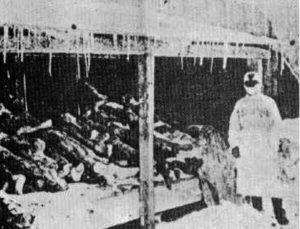 released, which most likely cost the lives of as many as 30,000 people, because the mice were infected with the Bubonic Plague, and they spread the disease. Few of those involved with Unit 731 have admitted their guilt. Some were caught in China at the end of the war, were arrested and detained, but only a handful of them were prosecuted for war crimes. In Japan, not one was brought to justice. In a secret deal, the post-war American administration gave them immunity for prosecution in return for details of their experiments. Some of the worst criminals, including Hisato Yoshimura, who was in charge of the frostbite experiments, went on to occupy key medical and other posts in public and private sectors…their guilty feelings, if they had any, existed only in their own minds.
released, which most likely cost the lives of as many as 30,000 people, because the mice were infected with the Bubonic Plague, and they spread the disease. Few of those involved with Unit 731 have admitted their guilt. Some were caught in China at the end of the war, were arrested and detained, but only a handful of them were prosecuted for war crimes. In Japan, not one was brought to justice. In a secret deal, the post-war American administration gave them immunity for prosecution in return for details of their experiments. Some of the worst criminals, including Hisato Yoshimura, who was in charge of the frostbite experiments, went on to occupy key medical and other posts in public and private sectors…their guilty feelings, if they had any, existed only in their own minds.
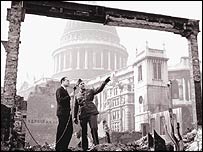 In March or 1941, the United States was largely considered neutral, so we could provide the countries, who were fighting Adolf Hitler, with war material. It was during this period of time, that the United Kingdom, an old enemy of the United States, since the United States fought against them for our independence, needed our help. Of course, we were allies by that time, and so the thought of a loan to the UK was not out o the question. The UK had been fighting against Adolf Hitler’s Germany army for a while by then, and funds were dwindling. The US loaned $4.33 billion to Britain in 1945, while Canada loaned US$1.19 billion in 1946, at a rate of 2% annual interest. It was a good deal, but in the end, the amount paid back was nearly double the amounts loaned in 1945 and 1946.
In March or 1941, the United States was largely considered neutral, so we could provide the countries, who were fighting Adolf Hitler, with war material. It was during this period of time, that the United Kingdom, an old enemy of the United States, since the United States fought against them for our independence, needed our help. Of course, we were allies by that time, and so the thought of a loan to the UK was not out o the question. The UK had been fighting against Adolf Hitler’s Germany army for a while by then, and funds were dwindling. The US loaned $4.33 billion to Britain in 1945, while Canada loaned US$1.19 billion in 1946, at a rate of 2% annual interest. It was a good deal, but in the end, the amount paid back was nearly double the amounts loaned in 1945 and 1946.
The United States was pulled into World War II shortly after, when Japan attacked Pearl Harbor. That marked to end of the program to provide military materials, because the United States was no longer considered neutral. At this point, the United States was very much needed in a very different way, and could not be neutral and be an effective help, but they also had a score to settle, and it could not be handled on the sidelines. The United States had hoped to sit this one out, but that was not to be. The Axis of Evil was winning against the Allied Nations, and they needed help, but it was the boldness of the attack on Pearl Harbor that finally awoke the sleeping giant that was the United States. The United States victory over Japan in the Battle of Midway was the turning point of the war in the Pacific. Then Germany invaded the Soviet Union. The Soviet Union defeated Germany at Stalingrad, marking the turning point of the war in Eastern Europe. As we all know, in the end the Allies were victorious in World War II.
There are still World War I debts owed to and by Britain. Since a moratorium on all debts from that conflict was agreed at the height of the Great Depression, no repayments have been made to or received from other nations since 1934. Despite the favorable rates there were six years in which Britain deferred payment because of economic or political crises. Britain settled its World War II debts to the United States and Canada when it paid the final 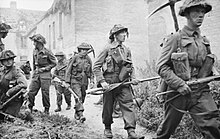 two installments in 2006. The payments of $83.25 million to the US and US$22.7 million to Canada are the last of 50 installments since 1950. Upon the final payments, the UK will have paid back a total of $7.5 billion to the US and US$2 billion to Canada. “This week we finally honor in full our commitments to the United States and Canada for the support they gave us 60 years ago,” said Treasury Minister Ed Balls at the time of those final payments. “It was vital support which helped Britain defeat Nazi Germany and secure peace and prosperity in the post-war period. We honor our commitments to them now as they honored their commitments to us all those years ago,” he added.
two installments in 2006. The payments of $83.25 million to the US and US$22.7 million to Canada are the last of 50 installments since 1950. Upon the final payments, the UK will have paid back a total of $7.5 billion to the US and US$2 billion to Canada. “This week we finally honor in full our commitments to the United States and Canada for the support they gave us 60 years ago,” said Treasury Minister Ed Balls at the time of those final payments. “It was vital support which helped Britain defeat Nazi Germany and secure peace and prosperity in the post-war period. We honor our commitments to them now as they honored their commitments to us all those years ago,” he added.

 After serving in the Navy for six years, my nephew, Allen Beach decided that it was time to move on to get the education that he wanted, which is hospital administration. He began his Navy career planning to become a pilot, but an injury forced him out of the program early on. He then decided to become a Corpsman, and found that he had a knack for that. His first duty station was in Bethesda, Maryland at Walter Reed Rational Military Medical Center, a term of service he was very proud of. While there, he was one of the EMTs who took care of the medical needs of the first family.
After serving in the Navy for six years, my nephew, Allen Beach decided that it was time to move on to get the education that he wanted, which is hospital administration. He began his Navy career planning to become a pilot, but an injury forced him out of the program early on. He then decided to become a Corpsman, and found that he had a knack for that. His first duty station was in Bethesda, Maryland at Walter Reed Rational Military Medical Center, a term of service he was very proud of. While there, he was one of the EMTs who took care of the medical needs of the first family.
After his term at Walter Reed Medical Center, Allen was stationed in Japan, which is where he met his future wife, Gabby, who was also a Corpsman stationed at the same base. Needless to say, Allen was very happy with his time in Japan, and meeting the love of his life. After that, Allen left the Navy, and for Gabby’s final year, they were stationed back at Walter Reed Medical Center. Now that both of them are out of the Navy, they have decided to move to Casper, Wyoming so that Gabby can continue her education too. Casper College has an excellent nursing program, and that is her chosen field. So, upon their release from the Navy, the headed west.
At this point, Allen and Gabby are living in an apartment on his mom and step-dad’s land outside of town. I’m sure that is quite a culture shock to them after the hustle and bustle of the Washington DC area. In addition, 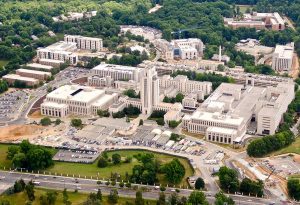 they are getting used to the winters in Wyoming. Not that they never got snow in Japan or in Washington DC, but I don’t think they had the winds like we have here. One nice thing about the move was the ability to be closer to family. Allen and Gabby were able to spend Christmas week in Rawlins with the family there, and they all had a great time. They have really taken to country living, and other than the severe cold causing their pipes to freeze, life is good. Allen is still looking for a job, so once he gets a job they will be set, as his classes are online. We are very proud of all of his s accomplishments, and we know that the future will be bright for both of them. Today is Allen’s birthday. Happy birthday Allen!! Have a great day!! We love you!!
they are getting used to the winters in Wyoming. Not that they never got snow in Japan or in Washington DC, but I don’t think they had the winds like we have here. One nice thing about the move was the ability to be closer to family. Allen and Gabby were able to spend Christmas week in Rawlins with the family there, and they all had a great time. They have really taken to country living, and other than the severe cold causing their pipes to freeze, life is good. Allen is still looking for a job, so once he gets a job they will be set, as his classes are online. We are very proud of all of his s accomplishments, and we know that the future will be bright for both of them. Today is Allen’s birthday. Happy birthday Allen!! Have a great day!! We love you!!
 I always knew that my uncle, George Hushman served in the United States Navy during World War II, but like many of the men who fight in wars, discussing what happened during their deployment is something that few want to talk about. My family spent quite a bit of time with Uncle George and Aunt Evelyn, who was my mom’s sister, and their family, but in all those visits, I never heard my dad, Allen Spencer, or my Uncle George ever talk about their time in the war. In fact, had it not been for an old picture of the two couples going to the Military Ball, I don’t think I would have even known what branch of the military Uncle George was in.
I always knew that my uncle, George Hushman served in the United States Navy during World War II, but like many of the men who fight in wars, discussing what happened during their deployment is something that few want to talk about. My family spent quite a bit of time with Uncle George and Aunt Evelyn, who was my mom’s sister, and their family, but in all those visits, I never heard my dad, Allen Spencer, or my Uncle George ever talk about their time in the war. In fact, had it not been for an old picture of the two couples going to the Military Ball, I don’t think I would have even known what branch of the military Uncle George was in.
Recently, while researching my family history, I came across some Muster Rolls for the United States Navy, for one USS Gurke. The USS Gurke was a DD Type destroyer whose mission was to provide anti-submarine and anti-surface defense to other surface forces. The Gurke is one of 103 Gearing Class destroyers that were built at 8 different shipyards. It was originally laid down as USS John A. Bole in October of 1944, but was renamed USS Henry Gurke (DD-783) prior to her launching on February 15, 1945 at the Todd-Pacific Shipyards, Inc, in Tacoma, Washington. The ship’s sponsor was Mrs. Julius Gurke, mother of Private Gurke, for whom the ship was named. The destroyer was commissioned 12 May 1945, under the command of Commander 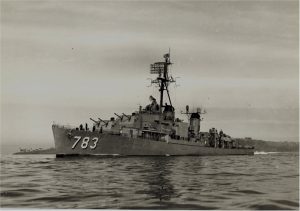 Kenneth Loveland. It was to this ship that my Uncle George was assigned beginning May 12, 1945. Prior to that he had been a S2c V6 on the USS LCI (G) 23, which was a transport ship.
Kenneth Loveland. It was to this ship that my Uncle George was assigned beginning May 12, 1945. Prior to that he had been a S2c V6 on the USS LCI (G) 23, which was a transport ship.
On the Gurke, Uncle George had a rating of S1c V6. I wasn’t sure what that meant, but I’m sure that any navy veteran would know. A V6 is a person who volunteered in World War II. As a V6 they had to be discharged by six months after the war was over. An S1c was a seamen first class. So now I knew what my uncle did during the war. Seaman first class was the rank right below a Petty Officer. The Seaman did a variety of jobs onboard the ship and could have worked anywhere on the ship. I suppose it would be a rank similar to the private, or in non-military verbiage, a laborer. That was the rank that many men went into the navy with, but a seaman first class was no longer a trainee. He had been trained to do his duties, and didn’t have to be told.
After a shakedown along the West Coast, the Gurke sailed for the Western Pacific August 27, 1945, reaching  Pearl Harbor on September 2nd. From there she continued west to participate in the occupation of Japan and former Japanese possessions. Returning to home port of San Diego, in February 1946, the Gurke participated in training operations until September 4, 1947, when she sailed for another WestPac cruise. Two further WestPac cruises, alternating with operations out of San Diego, and a cruise to Alaska in 1948 aiding the celebration of the 50th anniversary of the Yukon gold rush, filled Gurke’s schedule until the outbreak of the Korean War. Of course, I assume that upon Gurke’s return to her home port of San Diego, my uncle was either assigned to another ship, was at home port, or discharged. I am very proud of his service. Today is Uncle George’s 93rd birthday. Happy birthday Uncle George!! Have a great day!! We love you!!
Pearl Harbor on September 2nd. From there she continued west to participate in the occupation of Japan and former Japanese possessions. Returning to home port of San Diego, in February 1946, the Gurke participated in training operations until September 4, 1947, when she sailed for another WestPac cruise. Two further WestPac cruises, alternating with operations out of San Diego, and a cruise to Alaska in 1948 aiding the celebration of the 50th anniversary of the Yukon gold rush, filled Gurke’s schedule until the outbreak of the Korean War. Of course, I assume that upon Gurke’s return to her home port of San Diego, my uncle was either assigned to another ship, was at home port, or discharged. I am very proud of his service. Today is Uncle George’s 93rd birthday. Happy birthday Uncle George!! Have a great day!! We love you!!
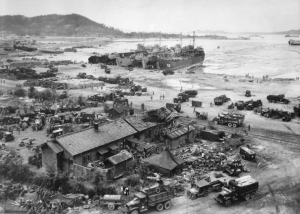 The Korean War began on June 25, 1950, when 90,000 North Korean troops, under orders from Kim Song-Ju, stormed across the 38th parallel, catching the Republic of Korea’s forces completely off guard and throwing them into a hasty southern retreat. Two days later, United States President Harry Truman announced that the United States would intervene in the conflict, and on June 28 the United Nations approved the use of force against communist North Korea. On June 30, Truman agreed to send United States ground forces to Korea, and on July 7 the Security Council recommended that all United Nations forces sent to Korea be put under United States command. The next day, General Douglas MacArthur was named commander of all United Nations forces in Korea. North Korea’s evil dictator wanted to rule the whole nation, and he wouldn’t have stopped there. He had to be stopped. The war would go on for three long years, finally ending on July 27, 1953. The Korean War was memorialized in the minds of most people with the war series, MASH, which ran far longer than the war itself. Of course, it was a semi-fictional show about a Mobile Army Surgical Hospital in which the men and women did everything they could to put the injured soldiers back together after the ravages of battle, all the while, hating that they would go back to battle.
The Korean War began on June 25, 1950, when 90,000 North Korean troops, under orders from Kim Song-Ju, stormed across the 38th parallel, catching the Republic of Korea’s forces completely off guard and throwing them into a hasty southern retreat. Two days later, United States President Harry Truman announced that the United States would intervene in the conflict, and on June 28 the United Nations approved the use of force against communist North Korea. On June 30, Truman agreed to send United States ground forces to Korea, and on July 7 the Security Council recommended that all United Nations forces sent to Korea be put under United States command. The next day, General Douglas MacArthur was named commander of all United Nations forces in Korea. North Korea’s evil dictator wanted to rule the whole nation, and he wouldn’t have stopped there. He had to be stopped. The war would go on for three long years, finally ending on July 27, 1953. The Korean War was memorialized in the minds of most people with the war series, MASH, which ran far longer than the war itself. Of course, it was a semi-fictional show about a Mobile Army Surgical Hospital in which the men and women did everything they could to put the injured soldiers back together after the ravages of battle, all the while, hating that they would go back to battle.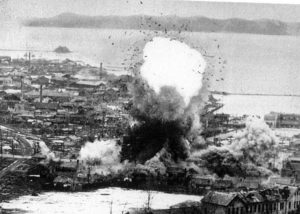
Now, we have another rogue dictator of North Korea, namely Kim Jong-un, who has developed a number of bombs, and doesn’t mind shooting them off as a warning to the rest of the world that not only is he crazy, but he is armed and crazy. Kim Jong-un lobs missiles over Japan on a regular basis, and has threatened Guam as well. Unfortunately, because of soft “leadership” on the part of President Obama, Kim Jong-un was allowed to proceed with his evil plans relatively unchecked, and now, he is an out of control leader who honestly thinks that he can control the world, and doesn’t care who he kills.
Now, we are in a position of trying to figure out how to stop Kim Jong-un. I don’t presume to know the answer to this dilemma, nor would I want to be in the shoes of those who will have to do something, because I don’t believe that this problem is going to be easily solved. I do know that something is going to have to be done.  When a dictator is willing to launch a nuclear bomb, they clearly do not care about life. All they care about is ruling the world. They don’t care about freedom, the lives of their own people or even the future of mankind. That makes them…insane, in my book. So, while I would not want to be in President Trump’s shoes concerning North Korea, I will support his decisions concerning military action, because I believe that he has the best interests of the United States and the world at heart, and I also do not believe that sanctions will work…now or ever. While I don’t think that war against North Korea would be easy, I also know that we can’t just sit idly by and let Kim Jong-un continue his rampage. It just might be time to do it again where North Korea is concerned.
When a dictator is willing to launch a nuclear bomb, they clearly do not care about life. All they care about is ruling the world. They don’t care about freedom, the lives of their own people or even the future of mankind. That makes them…insane, in my book. So, while I would not want to be in President Trump’s shoes concerning North Korea, I will support his decisions concerning military action, because I believe that he has the best interests of the United States and the world at heart, and I also do not believe that sanctions will work…now or ever. While I don’t think that war against North Korea would be easy, I also know that we can’t just sit idly by and let Kim Jong-un continue his rampage. It just might be time to do it again where North Korea is concerned.
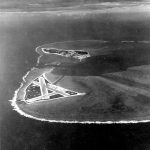 It’s a tiny island in the middle of the vast Pacific Ocean, so what possible impact could a battle for control of Midway Island have had? The answer is…much more than you might think. Sometimes, it’s not about the size of the nation, but rather about the might of its army. Japan is a little nation, it had built a mighty army and it was systematically defeating the Allies. Although other battles would soon make Midway seem like a small battle, no naval battle of World War II…and few others, if any, in all of naval history…would have so many momentous consequences ascribed to it as this one battle. So complete was Japan’s defeat at Midway, and so stunned was the Imperial High Command, that it would keep the results of the battle a secret from the Japanese people for the rest of the World War II.
It’s a tiny island in the middle of the vast Pacific Ocean, so what possible impact could a battle for control of Midway Island have had? The answer is…much more than you might think. Sometimes, it’s not about the size of the nation, but rather about the might of its army. Japan is a little nation, it had built a mighty army and it was systematically defeating the Allies. Although other battles would soon make Midway seem like a small battle, no naval battle of World War II…and few others, if any, in all of naval history…would have so many momentous consequences ascribed to it as this one battle. So complete was Japan’s defeat at Midway, and so stunned was the Imperial High Command, that it would keep the results of the battle a secret from the Japanese people for the rest of the World War II.
The story of the battle has been told many times over the years, and Midway continues to hold an almost mysterious place in the collective memory of the United States Navy and the United States in general. However, in recent decades a new generation of scholars has studied the facts of the battle. In some ways they 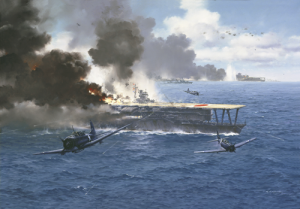 have removed the mystery of how such a “miracle” victory came to be and in other ways they have chalked it up to chance, luck, and the weather. The Americans had heard something about an attack, but the Japanese used the code location as “AF” to keep the attack location secret. The Americans suspected that it was Midway, so they sent a radio message that the island’s desalinization plant had broken down. The radio message was broadcast without encryption to ensure that Japan could read it if it was intercepted. The radio message was duly intercepted by Japan and reported by a message encoded in JN25 stating that AF’s desalinization plant was out of order and was intercepted by Station HYPO. “AF” was thus confirmed as Midway.
have removed the mystery of how such a “miracle” victory came to be and in other ways they have chalked it up to chance, luck, and the weather. The Americans had heard something about an attack, but the Japanese used the code location as “AF” to keep the attack location secret. The Americans suspected that it was Midway, so they sent a radio message that the island’s desalinization plant had broken down. The radio message was broadcast without encryption to ensure that Japan could read it if it was intercepted. The radio message was duly intercepted by Japan and reported by a message encoded in JN25 stating that AF’s desalinization plant was out of order and was intercepted by Station HYPO. “AF” was thus confirmed as Midway.
That was the beginning of the end for Japan. The Americans began to prepare for the attack. American scholars of Midway have long tried to explain away the many coincidences by characterizing the result of the battle as little short of a “miracle.” Walter Lord would name his 1967 narrative of Midway Incredible Victory, and 15 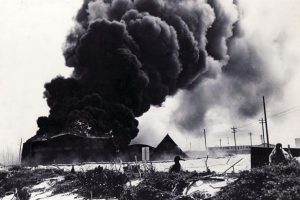 years later Gordon Prange’s posthumously published account of the battle was straightforwardly entitled Miracle at Midway. One battle participant’s memoir stated, “God was at Midway.” He saw divine intervention at work. The concept of the miracle has helped to explain the elements of the battle that have eluded detection, explication, or understanding. Some say that over the years, Midway has become less of a miracle, but that many mysteries remain. I say, that it was a miracle. God was at work at Midway. Even the weather worked against the Japanese when cloud cover prevented them from seeing what was right in front of them, and at the end of their attack…less than a week later, four Japanese fleet carriers would be twisted ruins on the bottom of the Pacific.
years later Gordon Prange’s posthumously published account of the battle was straightforwardly entitled Miracle at Midway. One battle participant’s memoir stated, “God was at Midway.” He saw divine intervention at work. The concept of the miracle has helped to explain the elements of the battle that have eluded detection, explication, or understanding. Some say that over the years, Midway has become less of a miracle, but that many mysteries remain. I say, that it was a miracle. God was at work at Midway. Even the weather worked against the Japanese when cloud cover prevented them from seeing what was right in front of them, and at the end of their attack…less than a week later, four Japanese fleet carriers would be twisted ruins on the bottom of the Pacific.

